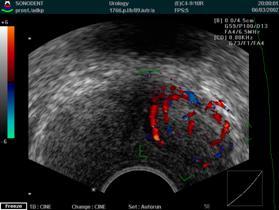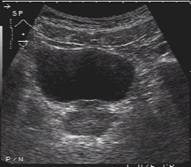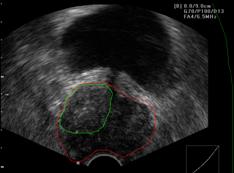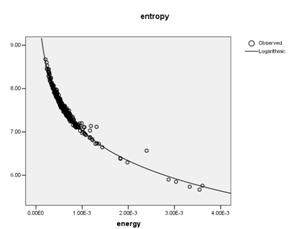DETECTION OF PROSTATIC ADENOCARCINOMA (ADKP) FROM ULTRASOUND IMAGES
Computerized image analysis and recognition for prostatic adenocarcinoma (ADKP) detection
Introduction
The prostatic adenocarcinoma (ADKP), the malignant tumor that causes prostatic cancer, is the most frequently met neoplasy at men. The incidence of prostatic adenocarcinoma increases continuously, being rarely present at men younger than 50. ADKP has often a heterogeneous aspect, due to fibrosis, to the interleave of tumoral tissues with benign parenchima, and also to the associated inflamatory processes. In general, the malignant nodules of ADKP are unprecisely delimited, because of their invasive character. In the diffuse form, the ADKP is characterized through an inhomogeneous aspect, through the dilation of prostate and through an interrupted contour of the prostate capsule. The usual techniques for prostate echography are the suprapubian echography, the transperineal echography and the transrectal ultrasound (TRUS), the last one being considered the most efficient.
|
Healthy |
|
|
|
ADKP (TRUS images) |
|
|
|
|
ADKP focal form |
ADKP diffuse form |
Fig.1. Visual aspect of healthy prostate and ADKP in Ultrasound images
Objectives
As the classical method - the biopsy, can be very dangerous for the
patients, we aim to develop non-invasive, computerized methods for
image analysis and recognition. Texture-based image analysis is
considered very appropriate for this purpose. Thus, the goals are:
• Build the imagistic textural model of ADKP consisting in:
• Automatic recognition of ADKP; differentiation of ADKP from normal tissue, benign tumors or metastases [9]• The relevant textural features, correlated with the visual characteristics of ADKP in its various evolution stages, that make the difference between: normal liver and ADKP; cirrhosis and ADKP [4], [5], [6], [10]
• The characteristic values of the textural features in the case of ADKP
• Identify the phase of ADKP evolution: ADKP segmentation and contour detection, position evaluation, size and shape analysis; characterization of vessels complexity from Doppler Ultrasound images.

Fig.2 Complex structure of vessels in the region of ADKP in Color Doppler Ultrasound images
Methodology
Image acquisition: We use TRUS (Trans-Rectal
Ultrasound Images) acquired through the ecograph using a well
established protocol concerning the device settings. All the images
that form a certain training set are obtained using the same settings
of the echographic device, in order to eliminate irrelevant, confusing
differences between classes.
Image analysis: The
image analysis consists in two phases - the computation of the textural
features on the region of interest, then the establishment of the
exhaustive set of relevant textural features. The computation of the
textural features is done through specific texture analysis methods:
The first order statistics of grey levels and color histograms [1], [2] The Grey Level Co-occurrence Matrix (GLCM) as a second order statistic of grey levels and their associated parameters: correlation,energy, entropy, local homogeneity [2] Fractal-based methods: Box-Counting method, Hurst algorithm [3] Transform-based methods: Wavelet Transform, Gabor Transform [7], [8], [11] Univariate density modelling - in order to detect the bimodal features, that could influence the class parameter [6] Classifiers that include the extraction of relevant features - Bayesian Belief Networks, Decision Trees , Ada Boost , Support Vector Machine [4], [5], [10] Methods for the analysis of the mutual influence between the features (regression) [6]
Automatic recognition: The possibility of automatic (fully computerized) recognition of ADKP, using the relevant features, is also studied. The following classification methods are considered for this purpose: Bayesian classifiers, Artificial Neural Networks (ANN ), the Multilayer Perceptron method, Decision Trees, Ada Boost, Support Vector Machines (SVM).
Achievements
• Textural features computation, plotting and comparison• The imagistic textural model of ADKP
• the exhaustive set of independent relevant textural features for ADKP characterization :
• the specific values of the relevant textural features in the case of ADKP:• the average of gray levels, the GLCM energy, the GLCM contrast, the GLCM variance, the edge contrast, the edge frequency, the Hurst coefficient, the entropies computed after applying the Wavelet Transform
• High accuracy of HCC automatic recognition: about 90%• GLCM energy, GLCM contrast, GLCM variance and the average of the grey levels take low values, because the ADKP tumors were generally hypo-echoic
• Edge contrast, edge frequency, the Hurst coefficient and the entropies computed after applying the Wavelet Transform take high values, due to the complex structure of the ADKP tissue
Illustrations
|
|
|
|
Density Modelling: bimodal variable (GLCM variance) |
Logarithmic correlation between energy and entropy |
|
|
|
|
Bayesian Networks showing the exhaustive set of independent textural features that influence the ADKP decision |
|
Future goals
- Improving the experiments by collecting a larger number of
cases/class and making the comparison also with the other and the
benign prostate tumors
- Automatically detecting the evolution phase of ADKP
- Automatic segmentation of ADKP using the set of relevant textural parameters
References
[1] Clausi, D.A. (2002), "An analysis of co-occurrence texture
statistics as a function of grey level quantization", Canadian Journal
of Remote Sensing, vol. 28, no. 1, 2002, pp. 45-62
[2] Chen, S., K. Cheng, Y. Dai,Y.Sun, Y. Chen, Y. Chang, "The
representation of sonographic image texture for breast cancer using
co-occurrence matrix", Journal of Medical and Biological Engineering ,
vol. 25, no.4, 2005, pp.193-199
[3] Chikui, T., K. Tokumori, K. Yoshiura, K. Oobu, S.Nakamura, K.
Nakamura, "Sonographic characterization of salivary gland tumors by
fractal analysis" , Ultrasound in Medicine and Biology, vol. 31, no.
10, 2005, pp. 1297-1304
[4] Duda, R., P. E. Hart and D. G. Stork (2000); Pattern Classification (2nd ed), Wiley
Inter-science, 2003
[5] Hall, M., G. Holmes, "Benchmarking Attribute Selection Techniques
for Discrete Class Data Mining", IEEE Transactions on Knowledge and
Data Engineering, vol. 15, no.3, 2003, pp. 1 - 16
[6] Jain A K, R. Duin, J. Mao, "Statistical Pattern Recognition: A
Review", IEEE Transactions on Pattern Analysis and Machine
Intelligence, vol. 22, no.1, January 2000, pp. 4-37
[7] Madabhushi, A., M.D. Felman, D.N. Metaxas, J. Tomaszeweski, D. Chte
(2005), Automated Detection of Prostatic Adenocarcinoma From
High-Resolution Ex Vivo MRI, IEEE Transactions on Medical Imaging,
December 2005, pp. 1611-1626
[8] Stollnitz, E., Tony D. DeRose, and David H. Salesin, "Wavelets for
computer graphics",. IEEE Computer Graphics and Applications, vol. 15,
no.3, May 1995, pp.76-84
[9] Sujana, H., S. Swarnamani and S. Suresh, "Application of Artificial
Neural Networks for the classification of liver lesions by texture
parameters", Ultrasound in Med.[&] Biol., vol. 22, no. 9, 1996, pp.
I177- 1181,
[10] Witten, I., E. Frank, "Data Mining: Practical machine learning
tools and techniques," 2nd Edition, Morgan Kaufmann, San Francisco, 2005
[11] Yoshida, H.,D.Casalino, B. Keserci, A. Coskun, O. Ozturk and A.
Savranlar, "Wavelet-packet-based texture analysis for differentiation
between benign and malignant liver tumours in ultrasound images",
Physics in Medicine and Biology, no. 48, 2003, pp. 3735-3753
Publications
D. Mitrea, S. Nedevschi, M. Lupsor, R. Badea, I. Coman, "Exploring the textural parameters of ultrasound images to build an imagistic model for prostatic adenocarcinoma (ADKP)", Workshop on Computers in Medical Diagnoses WCMD 2007, Cluj-Napoca, Romania, September 6-8, 2007, published in ACAM Scientific Journal, vol. 16, no. 3, 2007, pp.11-19
D. Mitrea, S. Nedevschi, P. Mitrea, M. Lupsor, R. Badea, I. Coman, "Exploring texture-based parameters for the automatic recognition of the hepatocellular carcinoma (HCC) and prostatic adenocarcinoma (ADKP) from ultrasound images", poster presented at the CEEX Conference, Sibiu, Romania, October 25-26, 2007
D. Mitrea, S. Nedevschi, M. Lupsor, R. Badea, "Texture-Based Methods for Noninvasive Evaluation of Diffuse Liver Diseases, Liver Cancer and Prostate Cancer from Ultrasound Images", The 6-th Joint Conference on Mathematics and Computer Science (MACS 06), Pecs, Hungary, July 12-15 2006, pp.65








